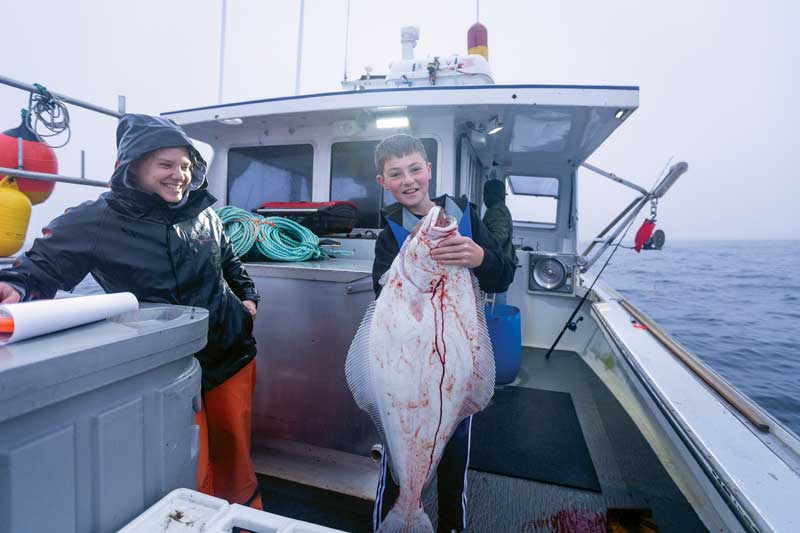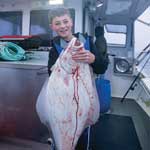It’s 3 a.m. on a mid-September morning as Captain Matt Trundy swings his 43-foot fishing boat F/V Savanna Says toward the thorofare off Stonington Harbor. A slight breeze ripples the waters carrying a familiar autumn feel. Sea conditions are favorable and Captain Trundy and his crew should arrive over the Outer Fall fishing grounds by sunrise. Located 34 nautical miles south of Isle Au Haut, these grounds on the north edge of Jefferys Bank have historically been home to cod, haddock, and other groundfish species. Once they arrive at their destination, the crew will get busy, setting out hook gear to catch and sample fish as part of the Eastern Gulf of Maine Sentinel Survey. Pat Shepard, Collaborative Research Specialist at the Maine Center for Coastal Fisheries (MCCF), coordinates the annual survey and today, he is accompanied by UMaine graduate student Robyn Linner.
Trundy is one of several fishermen assisting with this research project, which provides information about groundfish in this part of the Gulf of Maine where populations remain depleted. He chose today’s sampling location because, according to his father’s fishing logs, Ronnie Trundy on F/V Scamp II caught a pile of fish there on this same September day in 1995. Whether that’s nostalgia, superstition, or sensibility, on this day, 25 years later, the research team also had a decent day, landing cod, haddock, and a few redfish. This local knowledge underpins most of the work of the scientists at MCCF; Trundy is happy to help because he wants his son to be able to fish these waters, like his father before him.

Will cod recover in this part of the gulf? What are they eating? Does the return of alewife to restored rivers help this recovery? What are the other ecological factors that will determine whether other species of fish will return to harvestable levels? And if they do, how can we manage those populations better?
These are all questions that the group at MCCF is exploring through research, management and education. Collaboration is key across all of this work, particularly with fishermen like Captain Trundy. During a more recent trip, his 10 year old son Wes had the thrill of his life when he hooked up on a 40 pound halibut. “We have the opportunity to put that enthusiasm and knowledge that fishermen have to good use helping us to ask better questions and to find better answers that improve science and management,” says Pat Shepard.
On the steam back to shore, Shepard cooks up a meal on the portable grill while Linner methodically dissects today’s samples, putting little bits of fish parts into tiny tubes, painstakingly labeled for delivery to the laboratory. Lobster may not last forever, but we at MCCF believe we can still fish forever, and the likelihood of success is much greater when we collaborate with knowledgeable and dedicated fishermen.
It’s all part of our mission at the Maine Center for Coastal Fisheries: To secure a sustainable future for fisheries and fishing communities in eastern Maine and beyond.

For more information and to support this work, go to www.coastalfisheries.org








